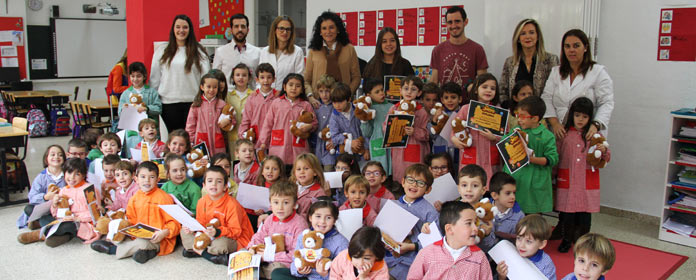A video game for children with dyslexia
47 primary school students from high school Teresianas have tested this tool, called 'Jellys', designed by researcher from the University of Navarra.

PHOTO: Elena Beltrán
47 primary school students from high school Teresianas in Pamplona have tested a video game from the University of Navarra, called 'Jellys', which seeks to improve reading comprehension in children with dyslexia. It has been designed by Mikel Ostiz as part of the doctoral thesis that he is doing in the group 'Mind-brain' of the Institute for Culture and Society (ICS) of the University of Navarra, the Basque Center on Cognition Brain and Language (BCBL) and the University of Vic thanks to a scholarship of the Obra Social "La Caixa". Today he has given them diplomas and a detail to recognize their partnership.
As he explains, the participation of the children consisted of using the video game during a total of 16 sessions of 15 minutes, at schedule school. In addition, they took psychological tests before and after the video game (reading, visual attention, rhythm, etc.), as well as motivation questionnaires and live usability tests, focused on design and the functioning of the video game.
The group was not specifically for children with dyslexia," he explains, "because we wanted to see in a relatively large and homogeneoussample the effect of the video game, because if there is an improvement in reading in the general population, this is especially interesting for children with reading difficulties.
He adds that the tests were carried out in a playful symbolic framework , "where both the tests and playing the video game were part of a narrative centered on the characters of the game (the adventurers who must save the jelly creatures from the evil crocodile), with a point system that each child placed in the form of stickers on their own card of points each time they performed one of the tests".
The PhD student of the ICS emphasizes that the experience started from two questions. The first is whether the video game, by training the rhythm and visual attention, can improve reading, although for this "we still need to analyze in depth the data collected". The second is whether Jellys is in itself an interesting and motivating tool for children, to which he responds that "children value the characters and the story as very motivating, and are interested in continuing to play".
Role of the facultyMikel Ostiz also thanks the teachers for their role as facilitators, "as they have made it possible to carry out the tests by giving up the first few minutes of class to play the video game for several weeks. This has allowed us to concentrate the experience and collect a lot of data that without these facilities would have been complicated".
These tests have been another milestone in his thesis , which is in the final stretch. One of the remaining challenges is to "analyze well the huge amount of data collected, because in addition to the tests and trials, we have captured data of use in real time". With all this, he will draw the conclusions of the study on the effectiveness and the design of the video game and will write the thesis "not as a period, but as a period, that is, to serve as a support to continue working on improving 'Jellys'".
